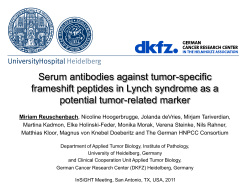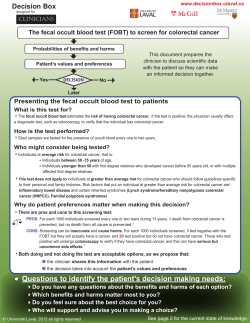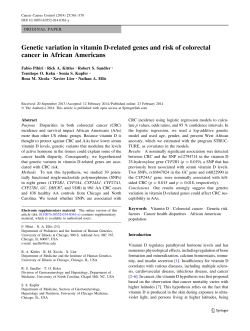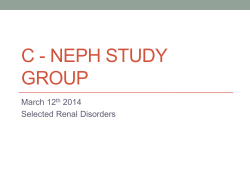
Document 713
DOI:http://dx.doi.org/10.7314/APJCP.2012.13.8.3873 Colorectal Cancer and the Metabolic Syndrome: a Malaysian Multi-Centric Case-Control Study RESEARCH ARTICLE Colorectal Cancer and its Association with the Metabolic Syndrome: a Malaysian Multi-Centric Case-Control Study V Ulaganathan1, M Kandiah1*, MS Zalilah1, JA Faizal2,3, H Fijeraid2,3, K Normayah 2,4, BH Gooi2,5, R Othman2,6 Abstract Objective: Colorectal cancer (CRC) and the metabolic syndrome (MetS) are both on the rise in Malaysia. A multi-centric case-control study was conducted from December 2009 to January 2011 to determine any relationship between the two. Methods: Patients with confirmed CRC based on colonoscopy findings and cancer free controls from five local hospitals were assessed for MetS according to the International Diabetes Federation (IDF) definition. Each index case was matched for age, gender and ethnicity with two controls (140: 280). Results: MetS among cases was highly prevalent (70.7%), especially among women (68.7%). MetS as an entity increased CRC risk by almost three fold independently (OR=2.61, 95%CI=1.53-4.47). In men MetS increased the risk of CRC by two fold (OR=2.01, 95%CI, 1.43-4.56), demonstrating an increasing trend in risk with the number of Mets components observed. Conclusion: This study provides evidence fora positive association between the metabolic syndrome and colorectal cancer. A prospective study on the Malaysian population is a high priority to confirm these findings. Keywords: Multicentric case-control study - metabolic syndrome - colorectal cancer - Malaysia Asian Pacific J Cancer Prev, 13, 3873-3877 Introduction The rapid socioeconomic development and dramatic changes in the lifestyles of Malaysia has led to a host of non-communicable diseases. Over the last two decades, CRC is one of leading causes of death in Malaysia. CRC accounts for about 9.2% of all medically certified deaths (Wendy and Radzi, 2010). Almost 26% of deaths from CRC can be reduced by modifying lifestyle, especially dietary intake, smoking and physical activity (Chustecka, 2009). The most dominant and consistent metabolic risk factors for CRC are obesity, high fasting blood glucose, high blood pressure and abnormal blood lipid (high serum triglyceride and low high-density lipoprotein (HDL) cholesterol), which collectively are known as metabolic syndrome (MetS) (Giovannucci, 2007). Several criteria have been proposed to describe metabolic syndrome. Currently, among the most widely used are the definitions proposed by World Health Organization (WHO) (Stensvold et al., 2011), National Cholesterol Education Program Adults Treatment Panel III (NCEP ATP III) (Grundy et al., 2005) and International Diabetes Federation (IDF) criteria (Alberti et al., 2009). MetS is now a widespread global entity. Approximately 20%-30% of the population in industrialized countries has MetS (Grudy, 2011). In Malaysia, MetS as defined by IDF (2006) criteria, affects an estimated 36.5% and 50.5% of adult males and females respectively and about 39% and 45.9% according to the NCEP III Criteria (Metabolic Syndrome Study of Malaysia) (Nazaimoon, 2010). Since MetS is composed of a variety of pathologies, it can cooperatively contribute to cancer development and progression. However studies linking MetS to CRC are few (Ahmed et al., 2006; Cowey and Hardy, 2006). Although the exact association is still unclear, lifestyle risk factors contributing to MetS and further CRC risk have been actively investigated. Therefore, the present study aims to determine the relationship between MetS with the risk of CRC. Materials and Methods Study Location and study subjects This multi-centric hospital-based case-control study was conducted in five selected hospitals in Peninsular Malaysia which are Hospital Kuala Lumpur (HKL), Hospital Putrajaya (HPJ), Hospital Selayang (HS), Department of Nutrition and Dietetics, Faculty of Medicine and Health Sciences, University Putra Malaysia, 2Department of Surgery, 3Hospital Kuala Lumpur, 4Hospital Selayang, 5Hospital Putrajaya, 6Hospital Pulau Pinang, 7Hospital Sultanah Aminah. Kuala Lumpur, Malaysia *For correspondence: mirnamogan@yahoo.com 1 Asian Pacific Journal of Cancer Prevention, Vol 13, 2012 3873 V Ulaganathan et al Hospital Sultanah Aminah (HAS) and Hospital Pulau Pinang (HPP). These hospitals were selected because they are substantial hospitals with heavy case workloads dealing with CRC and have reported the highest incidence of CRC of about 60-80 new cases per year over the years (Wendy and Radzi, 2010). The subjects of this study were the patients who were newly diagnosed with CRC (cases) based on colonoscopy findings and histopathology reports and patients who were identified as negative for CRC after a complete colonoscopy (controls). Each case was matched to two controls (140: 280) for age, sex and ethnicity. The CRC cases were identified either by the gastroenterologists, colorectal surgeons, pathologists or oncologists working in these five hospitals. Those patients who were suspected to have tumor-like-mass during colonoscopy but upon the histopathology report found to be negative for malignancy and fulfilled the other inclusion criteria were recruited as control subjects. Study Instrumentation Questionnaire and physical measurement: All data were collected during a face to face interview and direct measurement with the subjects. The information that was elicited from the subject’s personal information is age, gender, ethnicity, educational background, current occupation, household income and marital status. Anthropometric measurements were taken directly after the interview with the subjects. Waist circumferences was measured using a non-elastic measuring tape seca 201 (SECA, Vogel & Halke GmbH & CO. KG, Hamburg, Germany) and recorded to the nearest 0.1 centimetre. Blood pressure was measured using the Omron Automatic Blood Pressure Monitor T8 (Coleman et al., 2008). Waist circumference and blood pressure were further categorised according to cut off recommended for Asians by International Diabetes Federation (IDF) definition for MetS assessment (Zimmet et al., 2005). Waist circumference 90cm or more for men and 80cm or more for women is currently considered as a core criterium for MetS. Meanwhile, subjects with systolic blood pressure 130 mmHg or more and/or diastolic blood pressure 85 mmHg or more were classified as having elevated blood pressure (Alberti et al., 2009). Biochemical analysis: Ten millilitres of fasting blood sample of venous blood was collected by a trained and qualified paramedic from each hospital. Plasma lipids (HDL-cholesterol and triglyceride) and fasting blood glucose were determined using Hitachi 902, automated clinical chemistry analyzer (Quoc et al., 2011). Collected blood samples were processed, separated and stored on the same day at the Chemical Pathology Laboratory, Faculty of Medicine and Health Science, Universiti Putra Malaysia. Blood samples were mixed well and were allowed to stand for 10 minutes followed by centrifugation for 10 minutes at 3,000 rpm. After centrifugation the clear supernatant was separated from the precipitate into Eppendorf tubes for the different tests. Specimens were stored at -80C until analysis. On the day of analysis, the specimens were thawed and mixed thoroughly. The hexokinase method was used on the Hitachi 902 3874 Asian Pacific Journal of Cancer Prevention, Vol 13, 2012 as recognized reference method to test glucose level in serum. Meanwhile, the Rate method and a single point calibration and enzymatic colorimetric method were used on the Hitachi 902 as recognized reference method to test HDL-cholesterol and triglyceride respectively (Roche/ Hitachi System Application Sheet for blood lipid and glucose, 2004). Elevated blood triglyceride levels (≥1.69 mmol/L (150 mg/dL), or specific treatment for this lipid abnormality), decreased levels of high-density lipoprotein cholesterol (<1.03 mmol/L (40 mg/dL) in men, and <1.29 mmol/L (50 mg/dL) in women or on treatment for lipid abnormality) and raised fasting glucose (≥100 mg/dL) were considered as components of MetS classification according IDF (Zimmet et al., 2005). Data analysis: All data were analysed using SPSS (version 19.0.). Descriptive statistics such as frequencies, percentages (%), means, ranges and standard deviations (SD) were used to describe the data. Categorical variables are reported as absolute number and percentage. Independent t-test was used to determine differences between case and control group for continuous variables (example: age, nutrition intake and etc.). Chi square (χ2) distribution was used to determine the association between categorical variables (example: sex, ethnicity and etc.). Values of p<0.05 was considered as statistically significant, and was used to reject the null hypothesis. Fisher’s exact test was used as an alternative to χ 2 analysis whenever there were more than 25% of the cells with less than 5, which made chi square analysis invalid (Fleiss, 1981). Odds Ratio (OR) was determined by Cox regression analysis to judge the strength of association of MetS and CRC. Results Socio-demographic characteristics According to Table 1, out of 140 cases and 280 control subjects, 57.1% were males and the remaining 42.9% were females. In terms of ethnic variation, the incidence of CRC was highest among the Chinese (41.4%) followed by Malays (30.0%) and Indians (27.5%). The majority of respondents in this study were above 50 years. However, most of the case subjects (32.1%) were in the 60-69 years age group, as opposed to only 28.9% of controls in the same age category. Chi-square test showed a significant difference between the groups for educational background (χ2=11.759, p=0.019). The Table 1 clearly shows that one-third of the study subjects were unemployed. About 10% more of subjects in the case group compared to controls fell in the low-income category (52.8% vs 42.1%). Majority (>80%) of study subjects are married in both groups. Chi-square test showed no significant difference between study groups for age distribution, current occupation, household income and marital status Prevalence of Metabolic Syndrome MetS was higher among females in both cases and controls (53.8% and 56.4% respectively), compared to males (46.2% in cases and 43.6% in controls). In cases, MetS was more prevalent among Malays (40.4%) DOI:http://dx.doi.org/10.7314/APJCP.2012.13.8.3873 Colorectal Cancer and the Metabolic Syndrome: a Malaysian Multi-Centric Case-Control Study followed by Chinese (35.4%) and Indians (24.2%). This was slightly different in controls where the higher prevalence of MetS among Malays (40.9%), and second being Indian (30.0%) and followed by Chinese (29.1%). Going by age groups, subjects aged 60-69 years exhibited the highest prevalence of MetS (33.3% in cases and 29.1% in controls). A steady increase in the prevalence of MetS with advancement in age was noticed among both cases and controls. Relationship between MetS with the risk of CRC The prevalence of MetS as defined by IDF (Table 3) was 70.7% (n=99) among cases and 39.3% (n=110) among controls. This study found MetS significantly increased risk of CRC more than two folds (OR=2.25, 95%CI=1.443.50) and independently increased CRC risk almost three folds (OR=2.61, 95%CI=1.53-4.47) (Table 3). In addition, there was a significant dose-response association between CRC risk and the number of MetS components for study subjects carrying 2 or more MetS components after adjustment for possible confounding factors. Addition of each of the MetS components significantly doubled the risk of CRC compared to previous where OR=6.72, 95%CI=1.33-33.9 (two components), followed by OR=9.61, 95%CI=1.89-48.8 (three components), OR=16.31, 95%CI=3.08-86.42 (four components) and OR=18.79, 95%CI=3.36-105.0 (five components). This trend is more obvious among men, where the risk of CRC was increased in men with MetS (OR=2.01, 95%CI=1.43-4.56), but not in women (OR=2.05, 95%CI=0.88-3.76). Men carrying 3 or more MetS components after adjustment for possible confounding factors found to increased risk of CRC. Each addition of MetS components in MetS found to double the risk of CRC among men where the ORs of CRC were 5.84 (95%CI=1.29-49.5) for subjects with 3 component of the MetS, 9.23 (95%CI=2.36-57.32) for those with 4 components and 20.5 (95%CI=2.67-103) for those with 5 components. Discussion Table 1. Socio-Demographic Characteristics Variables Case* Control* (N=140)(N=140) n (%) n (%) Age of respondents (years) 30-39 9(6.4) 40-49 17(12.1) 50-59 32(22.9) 60-69 45(32.1) >70 37(26.4) Mean age±SD (years) 60.8±11.7 Range (years) 31-79 Gender Male 80(57.1) Female 60(42.9) Ethnicity Malay 49(35.0) Chinese 58(41.4) Indian 33(23.6) Educational background Primary school 62(44.3) Secondary school 51(36.4) Certificates/STPM 1 (0.7) Tertiary 11 (7.9) No schooling 15(10.7) Current occupation Public sector 16(11.4) Private sector 23(16.4) Self-employed 22(15.7) Un-employed 50(35.7) Retired/ pension 29(20.7) Household income (RM) 0-500 74(52.9) 501-1000 17(12.1) 1001-2000 26(18.6) 2001-3000 12 (8.6) >3000 11(7.9) Marital status Single 7 ( 5.0) Married 121(86.4) Widowed 12 (8.6) χ2p 13 (4.6) 38 (13.6) 54 (19.3) 81 (28.9) 1.92 94 (33.6) 61.9±11.9- 31-80 ns - 100.0 6. 160 (57.1) 120 (42.9) - - 75.0 98 (35.0) 116 (41.4) 66 (23.6) - - 56 50.0 83 (29.6) 11.8a0.02 25.0 123 (43.9) 12 (4.3) 40(14.3) 22 (7.9) 0 51 (18.2) 75 (26.8) 32 (11.5) 88 (31.4) 0.56 34 (12.1) 118 (42.1) 0.49 38 (13.9) 72 (25.7) 32(11.4) 19 (6.8) 17 (6.1) 235 (83.9) 0.46 28(10.0) 31 ns ns ns *N=140, aFisher’s exact tests; ns= not significant Table 2. Prevalence of Metabolic Syndrome MetS has become a major public health issue in Characteristic International Diabetes Federation definition Malaysia. Several studies on MetS have been conducted on Case n=140 Control n=280 healthy population groups (Kamaruddin 2009; Nazaimoon et al., 2010) and on diabetic patients (Association, 2011) With MetS Without MetS With MetS Without MetS 99(70.7) 41 (29.3) 110 (39.3) 170(60.7) but its relationship with CRC have not been investigated hitherto. The current study found that MetS was highly Gender prevalent based on IDF criteria among CRC patients. The Male 46(46.2) 34 (82.9) 48 (43.6) 112(65.9) 100.0 Female 53(53.8) 7 (17.1) rationale for using IDF definition for MetS assessment 62 (56.4) 58(34.1) was based on mounting evidence that abdominal obesity Ethnic 6.3 10.1 20.3 Malay 40(40.4) 9 (23.0) 45 (40.9) 53(31.2)100.0 is common to each of the components of MetS and 32 (29.1) 84(49.4) incorporation of ethnic-specific waist circumference cut-75.0 Chinese 35(35.4) 23 (54.0) 25.0 30.0 Indian 24(24.2) 9 (23.0) 33 (30.0) 33(19.4) offs (Snehalatha et al., 2003; Tan et al., 2004). Abdominal Age categories (years) obesity was found to be associated with insulin resistance 46.8 56.3 2(2.5) 30-39 7(17.1) 4 (3.6) 9(5.3) 75.0 (Yoshida et al., 2006), hypertension (Othman et al., 40-49 10(10.1) 7 (17.1) 54.2 16 (14.5) 22(12.9) 2008), hypercholesterolemia (Hossain et al., 2007), low50.0 50-59 27(27.3) 5 (12.2) 31.3 27 (24.5) 27(15.9) 30.0 HDL Cholesterol (Ahn et al., 2009), hyperglycemia and 60-69 33(33.3) 12 (29.3) 32 (29.1) 49(28.8) 50.0 diabetes (Stattin et al., 2007). Strong evidence was found >70 27(26.8) 10 (24.3) 31 (28.2) 63(37.1) linking to waist circumference with cardiovascular disease25.0 * IDF-International Diabetes Federation and MetS- Metabolic 31.3 38.0 31.3 23.7 Vol 13, 2012 Asian Pacific Journal of Cancer Prevention, 30.0 3875 25.0 1 6. 5 56 3 31 one sion ence ent ent 0 V Ulaganathan et al Table 3. Prevalence, Odds Ratio and 95% Confidence Interval of Metabolic Syndrome and Number of Metabolic Syndrome Components for Colorectal Cancer Based on International Diabetes Federation Definition Variables IDF Definition Case n (%) χ2p aOR (95%CI) b adjusted OR (95%CI) Control n (%) In both men and women MetS No 41 (29.3) 170(60.7) 12.00 0.00 1c 1c Yes 99 (70.7) 110(39.3) 2.25 (1.44-3.50) 2.61(1.53-4.47) No of MetS component 0 2 (1.4) 26(9.3) 31.10 0 1c 1c 19 (6.4) 51 (18.2)2.46 (0.48-12.53) 3.54 (0.60-20.1) 2 28 (20.0) 58(20.7) 6.01 (1.31-27.52) 6.72(1.33-33.9) 3 35 (25.0) 71(25.4) 6.50 (1.45-29.1) 9.61(1.89-48.8) 4 36 (25.7) 47(16.8) 11.20 (2.42-51.6) 16.30(3.08-86.4) 5 30(21.4) 27 (9.6) 18.70 (3.83-91.2) 18.80(3.36-105.0) In men MetS No 43 (53.8) 111(69.8) 5.99 0.01 1c 1c Yes 37 (46.2) 48(30.2) 1.94 (1.11-3.38) 2.01(1.43-4.56) No of MetS component 0 1 (1.2) 18(11.3) 20.80 0.00 1c 1c 16 (7.5) 36 (22.6)4.03 (0.43-37.9) 8.08 (0.38-32.0) 2 20 (25.0) 33(20.8) 10.50 (1.28-86.1) 5.74(0.33-48.7) 3 22 (27.5) 45(28.3) 9.48 (1.17-76.5) 5.84(1.29-49.5) 4 17 (21.2) 23(14.5) 11.20 (1.88-100.1) 9.23(2.36-57.3) 5 14(17.5) 4 (2.5) 24.10 (8.48-140.9) 20.50(2.67-103.5) In women MetS No 21 (31.3) 64(49.6) 5.99 0.01 2.72 (1.33-5.72) 2.05(0.88-3.76) Yes 46 (68.7) 65(50.4) No of MetS component 0 1 (1.7) 8(7.0) 8.77 0.12 1c 1c 13 (5.0) 15 (9.0)1.76 (0.16-19.2) 3.17 (0.16-64.8) 28 (13.3) 25 (15.0)3.20 (0.35-29.6) 4.73 (0.24-94.9) 3 13 (7.8) 26(15.6) 4.19 (0.51-34.5) 7.90(0.35-178.9) 4 19 (11.4) 24(14.4) 7.83 (1.90-68.4) 12.90(0.45-371.9) 5 16 (9.6) 23(13.8) 7.19 (1.81-63.5) 8.87(0.27-296.7) *IDF-International Diabetes Federation, MetS- Metabolic syndrome, aOR- Estimates of crude odds ratio from Cox regression equations, b OR- Estimates of odds ratio from Cox regression including terms for age, sex, ethnic, education background, components of MetS, obesity related biomarkers, energy intake, total physical activity level, current smoking status and current alcohol consumption, c reference category and CI-Confidence interval. and the likelihood that central obesity is an early step in the aetiological cascade leading to the full metabolic syndrome (Eckel et al., 2010). A recent study, Aleksandrova et al. (2011) reported that MetS as defined by IDF was associated with colon cancer (RR=1.91, 95%CI=1.47-2.42). Garow et al. (2008) identified individuals with MetS as defined by IDF had a 75% increased risk for colon or rectal cancer. In the ARIC study (Atherosclerosis Risk in Communities) which was conducted in United States between 1987 and 1989, CRC incidence and the number of MetS components, showed a positive association after age and gender adjustment (RR=1.49, 95%CI=1.0-2.4) (Ahmed et al., 2006). In the current study, MetS was found to double the risk of CRC in men but not in women. Similarly, an unmatched case control study in Switzerland (Pelucchi et al., 2010) reported that the risk of colorectal cancer increased in men with MetS as defined by IDF (OR=1.86, 95%CI, 1.21-2.86), but not in women. The disparity between the genders may be due in part to lifestyle factors such as more smoking and drinking and fewer doctors’ visits or cancer screenings among men (Sekeres, 2011). In conclusion, we found that simultaneous presence of 3876 Asian Pacific Journal of Cancer Prevention, Vol 13, 2012 two or more MetS factors was associated with an increase almost three-fold in CRC risk, and this trend was more obvious among men. An analysis of the cumulative effect of MetS components revealed increasing risk for CRC from one to five risk factors suggesting a dose response effect and this association were stronger in men than in women. Since, the combine presence of these two or more components, significantly associated with CRC, this supports our findings that MetS as entity increases the risk of CRC. Our data suggest the possibility that by decreasing even one or two of the components of the MetS may reduce the overall risk of incident CRC. The components of the MetS are not only common, but the correlations among them are, in many cases, significant. It may be that intervention of one or two of the components may have an effect on the other. This strategy can be conveyed easily to the public in order to reduce prevalence of MetS and subsequent CRC risk, rather than scientific explanations. Data obtained is critical for future studies to determine whether there is a single pathophysiologic mechanism underlying this cluster of risk factors which will be useful as biomarker for CRC risk assessment, screening, DOI:http://dx.doi.org/10.7314/APJCP.2012.13.8.3873 Colorectal Cancer and the Metabolic Syndrome: a Malaysian Multi-Centric Case-Control Study prognosis and treatment. If a single mechanism can be explained, this study presents opportunities for the development of therapeutic options with efficacy in treating multiple traits simultaneously. With any observational study, there is potential for residual and unmeasured confounding. The analyses presented here have been controlled for all the possible confounding factors as identified in the literature. However, it is still possible that other nutritional or lifestyle factors that have yet to be identified which may confound the relationship between lifestyle and CRC. As this is a retrospective case-control study with inherent study limitations, prospective studies should be carried out with focus on modifiable risk factors for CRC and other common cancers among Malaysians to strengthen the findings of this study. Such studies should include representative samples from each of the major ethnic groups in Malaysia to examine ethnic and socio- economic differentials in CRC risk. Acknowledgements This work was supported by the fund from Fundamental Research Grant Scheme (FRGS), Universiti Putra Malaysia (04-11-08-625FR). References Ahmed RL, Schmitz KH, Anderson KE, et al (2006). The metabolic syndrome and risk of incident colorectal cancer. Cancer, 107, 28-36 Ahn J, Lim U, Weinstein SJ, et al (2009). Prediagnostic total and high-density lipoprotein cholesterol and risk of cancer. Cancer Epidemiol Biomarkers Prev, 18, 2814-21 Alberti KG, Eckel RH, Grundy SM, et al (2009). International diabetes federation task force on epidemiology and prevention, national heart, lung, and blood institute, american heart association, world heart federation, international atherosclerosis society, international association for the study of obesity: harmonizing the metabolic syndrome: a joint interim statement of the international diabetes federation task force on epidemiology and prevention; national heart, lung, and blood institute; american heart association; world heart federation; international atherosclerosis society; and international association for the study of obesity. Circulation, 120, 1640-5. Aleksandrova K, Boeing H, Jenab M, et al (2011). Metabolic syndrome and risks of colon and rectal cancer: The european prospective investigation into cancer and nutrition study. Cancer Prev Res, 4, 1873-83. Chustecka Z (2009). Esophageal cancer in patients taking oral bisphosphonates. http://www.medscape.com/ viewarticle/586127. Accessed on: 22nd December 2011. Coleman MP (2008). Cancer survival in five continents: a worldwide population-based study (CONCORD). Lancet Oncol, 9, 730-56 Cowey S, Hardy RW (2006).The metabolic syndrome: a highrisk state for cancer? Am J Pathol, 169, 1505-22. Eckel RH, Alberti KG, Grundy SM, et al (2010). The metabolic syndrome. The Lancet, 375, 181-3. Fleiss JL (1981). Statistical Methods for Rates and Proportions. 2d ed. New York: John Wiley & Sons, Inc. Garow D (2008). Metabolic syndrome is a risk factor for colorectal cancer in the United States. American College of Gastroenterology 2008 Annual Scientific Meeting. October 6. Giovannucci E (2007). Metabolic syndrome, hyperinsulinemia, and colon cancer: a review. Am J Clin Nutr, 86, ?-?. Grundy SM (2011). The metabolic syndrome. Atlas Of Atherosclerosis And Metabolic Syndrome,1-26 Grundy SM, Brewer B Jr, Cleeman JI, et al (2005). Definition of metabolic syndrome: Report of the National Heart, Lung, and Blood Institute/American Heart Association Conference on Scientific Issues Related to Definition. Circulation, 109, 433-8. Hossain P, Kawar B, Nahas ME (2007). Obesity and Diabetes in the Developing World -A Growing Challenge. N Engl J Med, 356, 213-5. Kamaruddin NA (2009). Metabolic Syndrome in Malaysia: Implications in Clinical Practice. Diabetes Asia 2009 on 8th of October 2009 at the Sunway Resort Hotel & Convention Centre, Kuala Lumpur [Abstract]. Nazaimoon WWM (2010). Metabolic Syndrome In Malaysia (MSSM). J Endocrine and Metabolism, 1, ?-?. Othman NH, Zin AAM (2008). Asian Pacific J Cancer Prev, 9, 747. Pelucchi C, Negri E, Talamini R, et al (2010). Metabolic syndrome is associated with colorectal cancer in men. Eur J Cancer, 46, 1866-72. Quoc MN, Sathanur RS, Ji HX, et al (2011). Elevated Liver Function Enzymes Are Related to the Development of Prediabetes and Type 2 Diabetes in Younger Adults: The Bogalusa Heart Study. Diabetes Care, 34, 2603-7. Roche/Hitachi System Application Sheet for blood lipid and glucose, 2004 Sekeres MA, Maciejewski JP, List AF, et al (2011). Perceptions of Disease State, Treatment Outcomes, and Prognosis Among Patients with Myelodysplastic Syndromes: Results from an Internet-Based Survey. The Oncologist, 16, 904-11 Snehalatha C, Viswanathan V, Ramachandran A (2003). Cut-off values for normal anthropometric variables in Asian Indian adults. Diabetes Care, 26, 1380-4. Stattin P, Björ O, Ferrari P, et al (2007). Prospective Study of Hyperglycemia and Cancer Risk. Diabetes Care, 30, 561-7. Stensvold D, Nauman J, Nilsen TI, et al (2011). Even low level of physical activity is associated with reduced mortality among people with metabolic syndrome, a population based study (the HUNT 2 study, Norway). BMC Medicine, 9, 109. Tan CE, Ma S, Wai D, et al (2004). Can we apply the National Cholesterol Education Program Adult Treatment Panel definition of the metabolic syndrome to Asians? Diabetes Care, 27, 1182-6. Wendy L, Radzi M (2010). National Cancer Patient RegistryColorectal Cancer. Med J Malaysia, 63, ?-?. Yoshida A, Matsutani Y, Fukuchi Y, et al (2006). Analysis of the factors contributing to serum retinol binding protein and transthyretin levels in Japanese adults. J Atheroscler Thromb, 13, 209-15 Zimmet P, Alberti G, Shaw J (2005). Mainstreaming the metabolic syndrome: a definitive definition. Med J Aust, 83,175-6 Asian Pacific Journal of Cancer Prevention, Vol 13, 2012 3877
© Copyright 2025





















